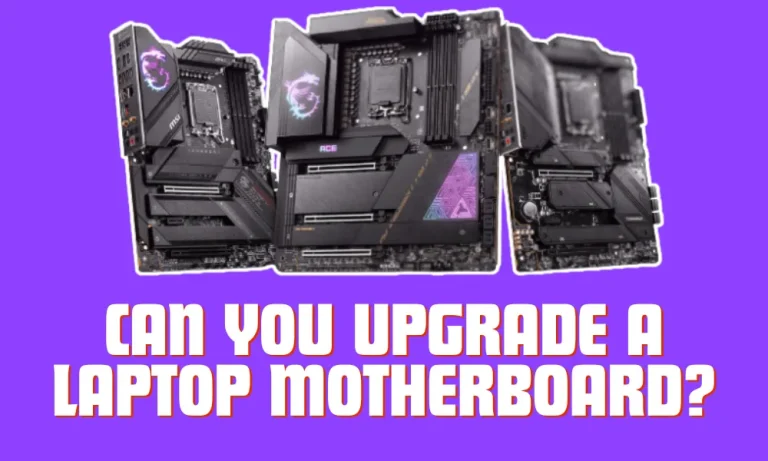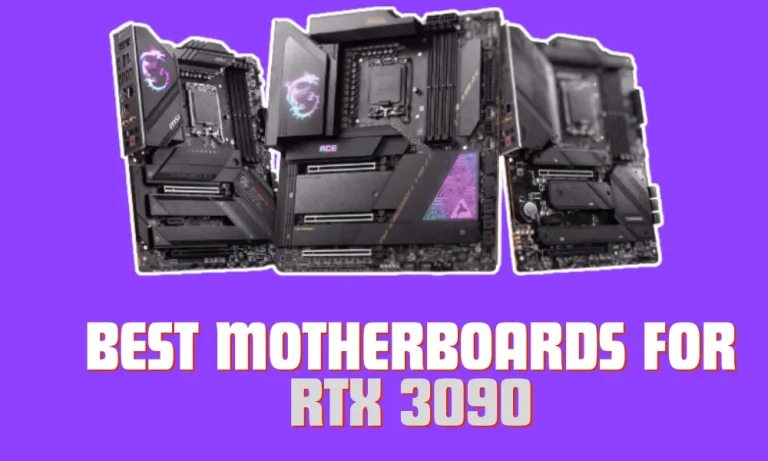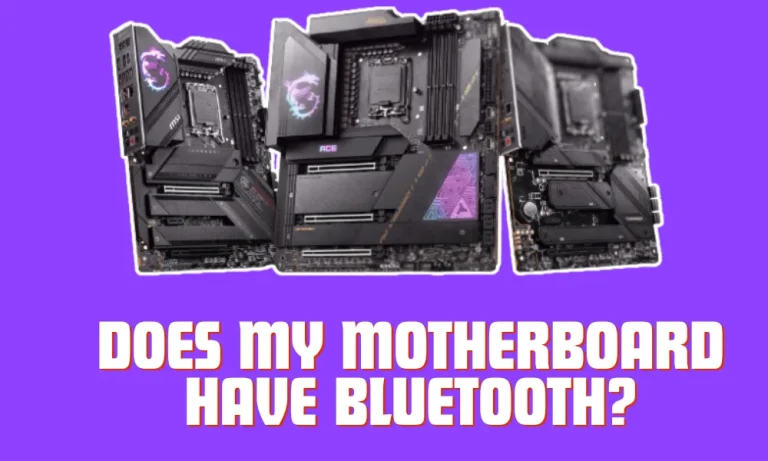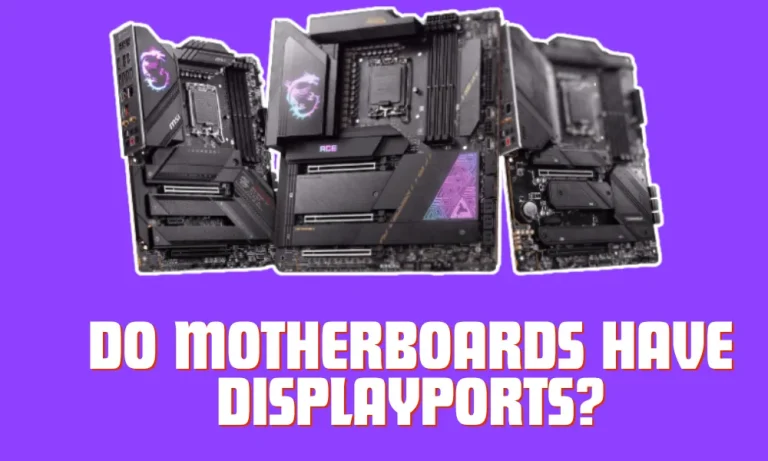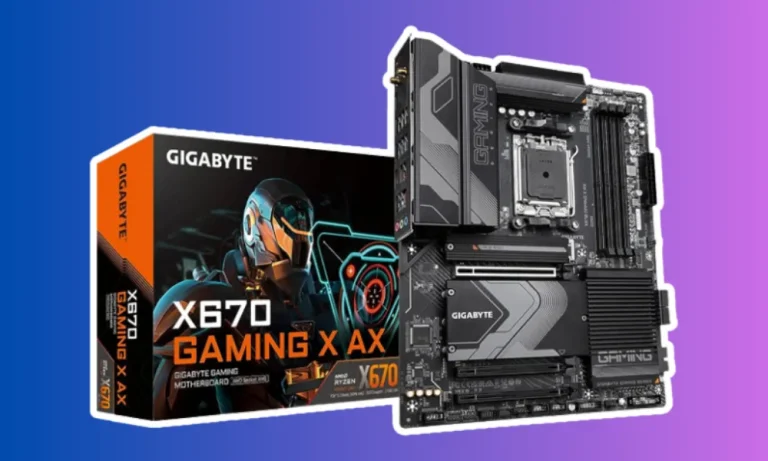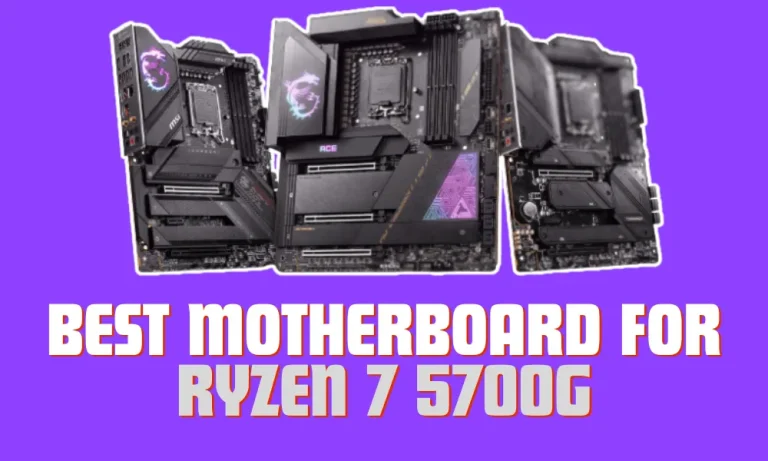5 Best Motherboards for RTX 3090 in 2024
So, you’ve got your hands on the mighty RTX 3090, a graphics card ready to take your gaming and content creation experience to new heights. But here’s the thing: to fully harness its immense power, you need a top-notch motherboard to keep up with its demands. In this guide, we’ll dive into everything you need to know about selecting the best motherboard for your RTX 3090 setup.
Best Motherboard for RTX 3090
| Product Name | Check Price |
|---|---|
| ASUS ROG Strix B560-F Gaming WiFi 6 | Check Price |
| MSI MPG Z590 Gaming Carbon WiFi | Check Price |
| Gigabyte B560 AORUS Pro AX | Check Price |
| ASRock Z590 Extreme WiFi 6E | Check Price |
| EVGA Z590 FTW WiFi | Check Price |
1. ASUS ROG Maximus XIII Hero

| Specification | Description |
| Brand | ASUS |
| Model | ROG Maximus XIII Hero |
| Form Factor | ATX |
| Socket | LGA 1200 |
| Memory Slots | 4x DDR4 DIMM |
| PCIe Slots | 3x PCIe x16, 1x PCIe x1 |
Let me start by saying that if you’re searching for a motherboard that can handle the monstrous power of an RTX 3090 while providing exceptional performance and reliability, look no further than the ASUS ROG Maximus XIII Hero. As a tech enthusiast with hands-on experience with this beastly combination, I am excited to share my detailed review.
First things first, let’s talk about specifications. The ASUS ROG Maximus XIII Hero is designed with gamers and content creators in mind. Its ATX form factor ensures compatibility with most PC cases, while its LGA 1200 socket allows seamless integration with Intel processors. With four DDR4 DIMM memory slots and three PCIe x16 slots (plus one PCIe x1 slot), this motherboard offers ample room for expansion and future upgrades without compromising performance.
Now, let’s dive into what makes this motherboard stand out from the crowd:
Features:
- Power Delivery: The robust power delivery system of the Maximus XIII Hero ensures stable voltage regulation to your RTX 3090 GPU, even during heavy workloads or intense gaming sessions.
- Enhanced Cooling: Equipped with multiple fan headers and comprehensive cooling options, including dedicated heatsinks for M.2 SSDs and VRMs, this motherboard keeps temperatures in check.
- Connectivity Galore: From USB 3.2 Gen 2 ports to Thunderbolt 4 support and dual Ethernet LAN, the Maximus XIII Hero offers a wide range of connectivity options for all your peripherals and networking needs.
- AI Overclocking: ASUS’ AI technology intelligently optimizes system performance based on real-time usage, ensuring you get the most out of your RTX 3090 without manual tweaking.
- Aura Sync RGB Lighting: Customize your gaming rig with stunning lighting effects using Aura Sync, which allows synchronization with other compatible devices for an immersive visual experience.
The ASUS ROG Maximus XIII Hero impressed me with its exceptional build quality and attention to detail. The power delivery system handled my RTX 3090 effortlessly, consistently performing even during demanding tasks. The enhanced cooling features kept temperatures at bay, preventing thermal throttling issues.
I also appreciated the extensive connectivity options on this motherboard, allowing me to connect multiple devices without hassle.
While the ASUS ROG Maximus XIII Hero is undoubtedly a top-of-the-line motherboard packed with impressive features, it does come with a premium price tag. This may be a drawback for budget-conscious users looking for more affordable alternatives.
Pros:
- Robust power delivery system
- Comprehensive cooling options
- Wide range of connectivity choices
- AI overclocking capabilities
- Stunning Aura Sync RGB lighting customization
Cons:
- Higher price point compared to other motherboards in its class
2. Gigabyte Z590 AORUS Xtreme

| Specification | Details |
| Socket | LGA 1200 |
| Chipset | Intel Z590 |
| Memory Slots | 4 x DDR4 DIMM |
| PCI Express Slots | 3 x PCIe x16, 2 x PCIe x1 |
| Storage | 6 x SATA III, 3 x M.2 |
| Networking | Intel WiFi 6E, Aquantia AQC107 Ethernet |
As an avid gamer and enthusiast, I recently upgraded my system to accommodate the powerful RTX 3090 graphics card. After extensive research and comparing various options, I settled on the Gigabyte Z590 AORUS Xtreme, as it toperfectly matchr my needs.
The first thing that caught my attention was its robust build quality. The motherboard features high-quality components and sturdy construction that exude durability. Installation was hassle-free thanks to well-labelled connectors and comprehensive documentation provided by Gigabyte.
One standout feature of the AORUS Xtreme is its excellent power delivery system. With a robust VRM design and multiple power phases, this motherboard ensures a stable voltage supply even during demanding gaming sessions or overclocking. This translates into smoother performance with minimal fluctuations or instability issues.
In terms of connectivity options, this motherboard has got you covered. It offers ample USB ports (including USB-C) for connecting peripherals and multiple expansion slots for additional cards like sound cards or capture devices. The inclusion of Intel WiFi 6E guarantees fast wireless internet speed, while the Aquantia AQC107 Ethernet provides reliable wired connectivity.
I must mention that one aspect where this motherboard truly shines is its exceptional audio quality. The built-in ALC1220-VB audio codec delivers crystal-clear sound output, immersing you in the gaming experience. Additionally, Gigabyte’s exclusive AMP-UP technology enhances audio performance further, making every game or movie more enjoyable.
Positive Balance:
- Robust build quality ensures durability
- Excellent power delivery for stable performance
- Ample connectivity options including USB-C and multiple expansion slots
- Fast wireless internet speeds with Intel WiFi 6E
- Exceptional audio quality with ALC1220-VB codec and AMP-UP technology
Negative Balance:
- Relatively higher price compared to other options on the market.
3. MSI MEG Z490 Godlike

| Specification | Description |
| Brand | MSI |
| Model | MEG Z490 Godlike |
| Form Factor | E-ATX |
| Socket | LGA 1200 |
| Memory Slots | 4x DDR4 DIMM |
| PCIe Slots | 4x PCIe x16, 2x PCIe x1 |
Let me take a moment to introduce you to a motherboard that truly lives up to its name – the MSI MEG Z490 Godlike. As an avid PC enthusiast with firsthand experience with this powerhouse combination, I’m thrilled to share my detailed review.
Before diving into they details, let’s start with the specifications. The MSI MEG Z490 Godlike is built for uncomGodlikeng performance and flexibility.Its E-ATX form factor and LGA 1200 socket offer seamless integration with Intel processors while providing ample room for expansion and customization. This motherboard sets itself apart by boasting four DDR4 DIMM memory slots and an impressive array of six PCIe slots (four x16 and two x1n.
Now, let’s explore what makes this motherboard truly god-like:
Features:
- ExtremgodlikeDesign: The robust power delivery system ensures stable power distribution even under heavy loads, allowing your RTX 3090 graphics card to perform at its best.
- Advanced Thermal Solutions: Equipped with multiple heatsinks, heat pipes, and fan headers strategically placed across the board, this motherboard monitors temperatures during intense gaming or demanding tasks.
- Lightning Fast Connectivity: With Thunderbolt™3 support and USB Type-C ports featuring SuperSpeed+ transfer rates, the MEG Z490 Godlike offers lightning-fGodlikea transfer and connectivity options.
- Audio Boost HD: Immerse yourself in high-quality audio with the built-in Audio Boost HD technology, delivering crystal-clear sound for an enhanced gaming and multimedia experience.
- Mystic Light Infinity II: Customize your rig’s lighting effects with Mystic Light Infinity II. This motherboard features RGB lighting on multiple zones, allowing you to create stunning visual displays that sync seamlessly with other compatible devices.
- Dual LAN with Wi-Fi 6E: Enjoy lag-free online gaming and fast internet speeds thanks to dual Ethernet ports and Wi-Fi 6E support.
The MSI MEG Z490 Godlike impressed me when I installed it in my system. Its extreme power design handled my RTX 3090 effortlessly, providing consistent performance during demanding tasks without hiccups. The advanced thermal solutions controlled temperatures even during extended gaming sessions, ensuring optimal performance. The lightning-fast connectivity options were a game-changer for transferring large files quickly. The customizable Mystic Light Infinity II also allowed me to create a visually stunning setup that stood out.
One aspect worth noting is that due to its E-ATX form factor, this motherboard requires a larger PC case for proper installation. It may be unsuitable for users looking for compact builds or those working within space constraints.
Pros:
- Robust power delivery system
- Advanced thermal solutions
- Lightning-fast connectivity options
- Crystal-clear audio quality
- Stunning RGB lighting customization
- Dual LAN with Wi-Fi 6E support
Cons:
- Requires a larger PC case (due to EATX form factor)
4. ASRock X570 Taichi

| Specification | Details |
| Socket | AM4 |
| Chipset | AMD X570 |
| Memory Slots | 4 x DDR4 DIMM |
| PCI Express Slots | 3 x PCIe 4.0 x16, 2 x PCIe 3.0 x1 |
| Storage | 8 x SATA III, 3 x M.2 |
| Networking | Intel Gigabit Ethernet, Wi-Fi AX |
As an enthusiastic gamer and hardware enthusiast, I recently upgraded my gaming rig to include the mighty RTX 3090 graphics card. After thorough research and consideration, I opted for the ASRock X570 Taichi motherboard, which perfectly complemented my high-performance needs.
One of the standout features that immediately caught my attention was its robust power delivery system. The motherboard boasts a premium VRM design with multiple power phases, ensuring a stable voltage supply even during intense gaming sessions or demanding overclocking. This translates into the consistent performance without noticeable frame rate drops or stability issues.
Installation of this motherboard was a breeze thanks to its user-friendly layout and comprehensive documentation provided by ASRock. The well-labeled connectors and easy-to-follow instructions made setting up my system hassle-free.
The connectivity options on the X570 Taichi are top-notch. It offers ample USB ports (including USB-C) for connecting various peripherals while providing multiple expansion slots for additional cards, such as sound cards or capture devices. Furthermore, with Intel Gigabit Ethernet and Wi-Fi AX support, you can enjoy lag-free online gaming or fast wireless internet speeds without hiccups.
In terms of storage capabilities, this motherboard truly shines with eight SATA III ports and three M.2 slot. Whether you have multiple SSDs or traditional hard drives, the X570 Taichi has ample space for your storage needs.
Positive Balance:
- A robust power delivery system ensures stable performance
- User-friendly installation process
- Ample connectivity option,s including USB-C and expansion slots
- Intel Gigabit Ethernet and Wi-Fi AX support for reliable networking
- Extensive storage capabilities with eight SATA III ports and three M.2 slots
Negative Balance:
- The motherboard’s size may be larger than standard, requiring a spacious PC case.
5. EVGA Z590 FTW WiFi

| Specification | Description |
| Brand | EVGA |
| Model | Z590 FTW WiFi |
| Form Factor | ATX |
| Socket | LGA 1200 |
| Memory Slots | 4x DDR4 DIMM |
| PCIe Slots | 3x PCIe x16, 2x PCIe x1 |
As a tech enthusiast who has delved into building high-performance systems, I’m excited to share my detailed review of the EVGA Z590 FTW WiFi motherboard. If you’re searching for a motherboard that can handle the sheer power of an RTX 3090 while providing exceptional performance and convenience, this option is worth considering.
Let’s start by taking a look at its specifications. The EVGA Z590 FTW WiFi features an ATX form factor, making it compatible with most PC cases. With an LGA 1200 socket and four DDR4 DIMM memory slots, this motherboard provides compatibility with Intel processors and ample room for upgrading your system’s memory capacity. It also boasts three PCIe x16 slots and two additional PCIe x1 slots to accommodate expansion cards such as graphics or sound cards.
Now let’s dive into what makes this motherboard stand out:
Features:
- Robust Power Design: The VRM (Voltage Regulator Module) design ensures stable power delivery to your RTX 3090 GPU during intense gaming sessions or resource-demanding tasks.
- Dual-Band Wi-Fi Connectivity: Built-in Wi-Fi functionality allows seamless wireless connectivity without additional adapters or cables.
- Enhanced Cooling Solutions: Equipped with multiple fan headers and heatsinks strategically placed across the board, the Z590 FTW WiFi keeps your system cool and prevents thermal throttling.
- High-Speed Storage Options: With multiple M.2 slots, this motherboard supports ultra-fast NVMe SSDs for rapid data transfer and reduced load times in games or applications.
- Customizable RGB Lighting: Personalize your setup with customizable RGB lighting options to create a visually stunning environment that matches your style.
- Convenient Connectivity: The Z590 FTW WiFi offers a wide range of connectivity options, including USB 3.2 Gen 2 ports, Ethernet LAN, audio jacks, and more for seamless device integration.
Pros:
- Robust power delivery
- Built-in dual-band Wi-Fi
- Enhanced cooling solutions
- High-speed storage support
- Customizable RGB lighting
- Wide range of convenient connectivity options
Cons:
- Requires a larger PC case (due to ATX form factor)
Buying Guide: Choosing the Best Motherboard for Your RTX 3090
When building a high-performance gaming or content-creation ril. The motherboard your system’s foundation, providing connectivity and compatibility with various components, including your powerful RTX 3090 graphics card. In this buying guide, I’ll walk you through important factors to consider when selecting a motherboard for your RTX 3090 setup.
- Compatibility: Ensure that the motherboard you choose supports Intel and AMD processors. For an RTX 3090, look for motherboards with an LGA 1200 socket (for Intel) or AM4 socket (for AMD). This ensures seamless integration between your chosen processor and GPU.
- Form Factor: Consider the form factor of the motherboard based on your case size and expansion needs. ATX motherboards offer more PCIe and memory slots than microATX or mini-ITX form factors but require larger cases.
- Power Delivery: A robust system ensures a stable voltage supply to your RTX 3090 during heavy workloads or intense gaming sessions. Look for motherboards with quality VRM designs that can handle high power demands without compromising performance.
- PCIe Slots & Expansion Options: Check how many PCIe x16 slots are available on the motherboard since high-end GPUs like the RTX 3090 require these. Consider other expansion options, such as M.2 slots for fast NVMe SSD storage or additional USB ports.
- Memory Support: Make sure the motherboard offers sufficient RAM support for optimal performance with demanding applications and games compatible with DDR4 memory modules.
- Connectivity Options: Evaluate connectivity features like USB ports (especially newer USB standards like USB-C), Ethernet LAN ports, built-in Wi-Fi capability, and audio jacks. These features enhance your overall user experience and provide seamless integration with other devices.
- Cooling Solutions: Look for motherboards with effective cooling solutions, such as multiple fan headers, heatsinks, or integrated liquid cooling options. Efficient cooling ensures that your components operate at optimal temperatures, preventing thermal throttling and extending their lifespan.
- Brand Reputation & Support: Consider a reputable brand that produces reliable motherboards with good customer support. Brands like MSI and EVGA have a solid track record in the industry.
FAQs
1. Can I use any motherboard with my RTX 3090?
No, not all motherboards are compatible with the RTX 3090. It would be best if you headed a motherboard that supports PCIe Gen4 x16 slots and has sufficient power delivery capabilities to handle the high power demands of the graphics card.
2. How many PCIe slots should a motherboard have for an RTX 3090?
Ideally, you should look for a motherboard with at least three PCIe x16 slots to accommodate the RTX 3090 and other expansion cards you may want to add.
3. What type of memory support is required for optimal performance with an RTX 3090?
To ensure optimal performance, choosing a motherboard that supports DDR4 memory modules running at higher frequencies (3200MHz or above,e) is recommended, as this can provide better bandwidth and overall system responsiveness when paired with an RTX 3090.
4. Do I need specific connectivity options for an RTX 3090 on my motherboard?
While not mandatory, having ample USB ports (including USB-C), Ethernet connectivity options such as Intel Gigabit Ethernet, and fast wireless internet speeds like Wi-Fi AX can enhance your overall gaming experience when using an RTX 3090-powered system.
5. Is it necessary to consider VRM quality on a motherboard for an RTX 3090 build?
Choosing a motherboard with a robust VRM (Voltage Regulator Module) design and multiple power phases is crucial when pairing it with an energy-hungry GPU like the RTX 3090. This ensures a stable voltage supply even under heavy load conditions, reducing potential instability issues while gaming or overclocking.
Conclusion
Choosing the best motherboard for your RTX 3090 is a critical decision that can significantly impact the performance and compatibility of your system. By considering factors such as compatibility, form factor, power delivery, expansion options, memory support, connectivity features, cooling solutions, and brand reputation/support, you can make an informed choice that meets your needs.
Whether you opt for a feature-packed motherboard from MSI or EVGA or explore other reputable brands in the market, ensure that it aligns with your requirements and provides a solid foundation for unleashing the full potential of your RTX 3090 graphics card. Happy building!

